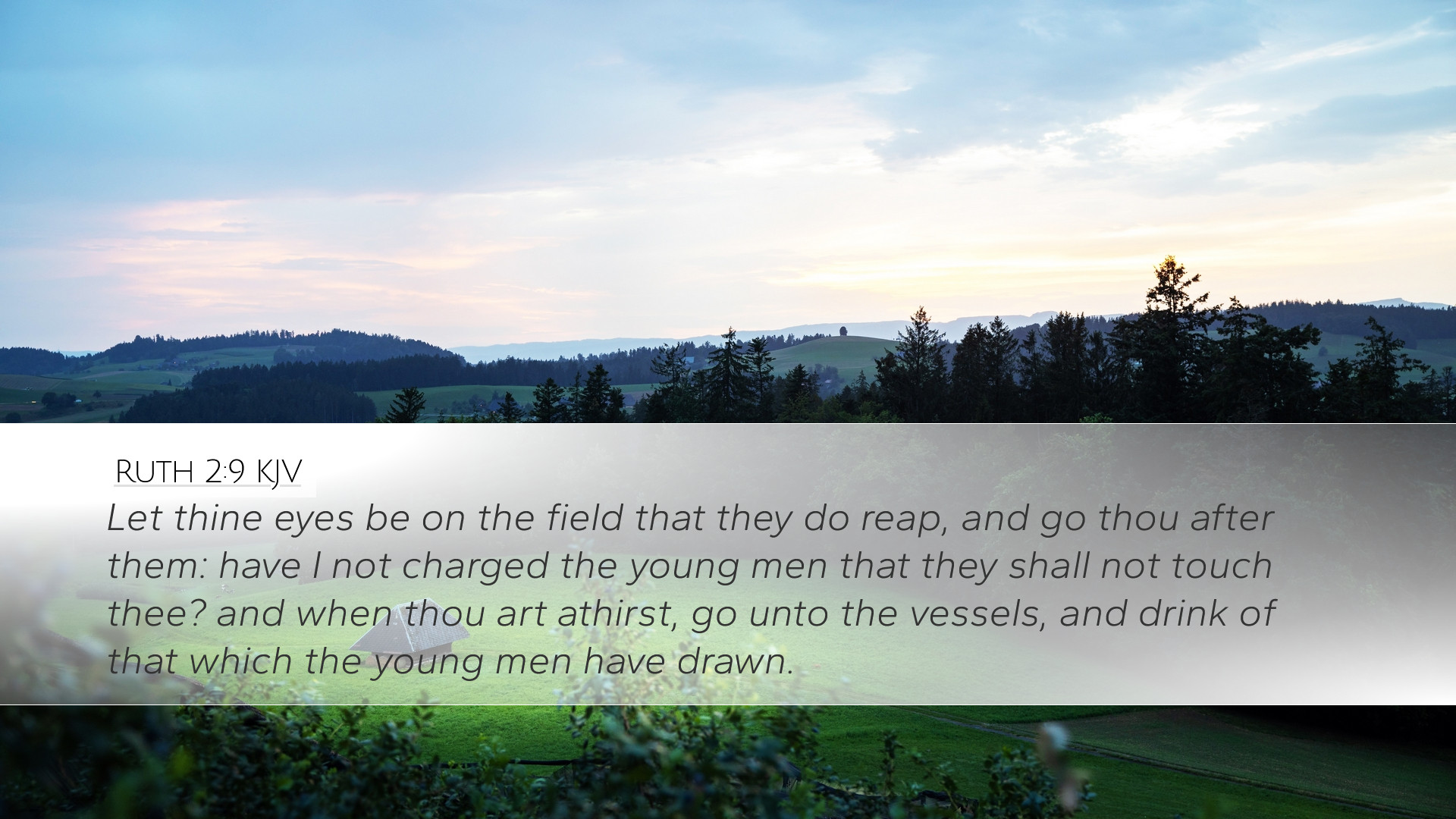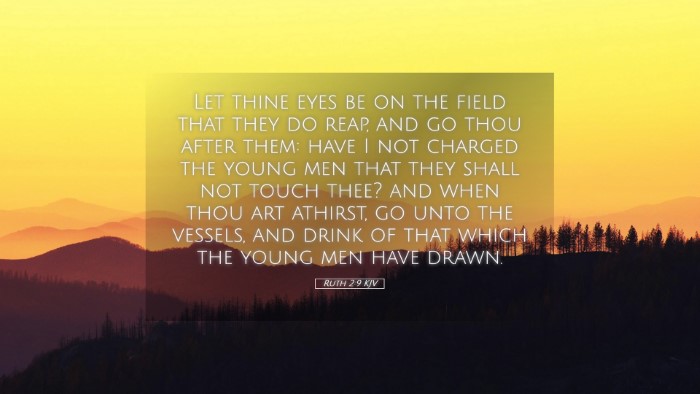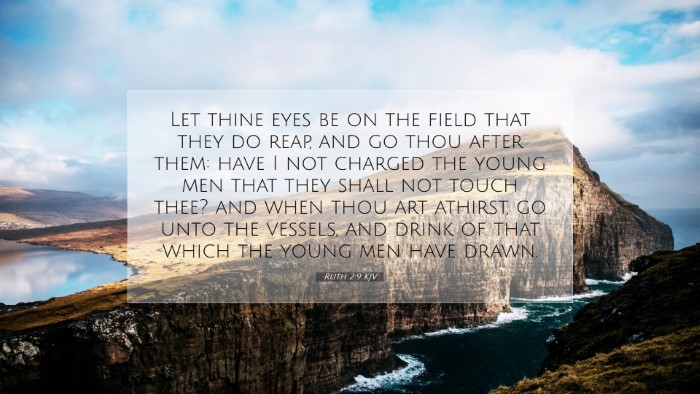Old Testament
Genesis Exodus Leviticus Numbers Deuteronomy Joshua Judges Ruth 1 Samuel 2 Samuel 1 Kings 2 Kings 1 Chronicles 2 Chronicles Ezra Nehemiah Esther Job Psalms Proverbs Ecclesiastes Song of Solomon Isaiah Jeremiah Lamentations Ezekiel Daniel Hosea Joel Amos Obadiah Jonah Micah Nahum Habakkuk Zephaniah Haggai Zechariah MalachiRuth 2:9
Ruth 2:9 KJV
Let thine eyes be on the field that they do reap, and go thou after them: have I not charged the young men that they shall not touch thee? and when thou art athirst, go unto the vessels, and drink of that which the young men have drawn.
Ruth 2:9 Bible Commentary
Commentary on Ruth 2:9
Bible Verse: Ruth 2:9 - "Let your eyes be on the field which they reap, and go after them. Have I not commanded the young men not to touch you? And when you are thirsty, go to the vessels and drink from what the young men have drawn." (NKJV)
Introduction
The Book of Ruth is a profound narrative that discusses God's providence, loyalty, and the integration of the Gentile into the community of Israel. Ruth 2:9, spoken by Boaz to Ruth, provides key insights into the themes of protection, provision, and divine favor. In this commentary, we present insights from notable public domain commentaries to enrich understanding of this significant verse.
Contextual Analysis
Historical Background: The setting of the Book of Ruth is during the time of the judges in Israel, where social and spiritual chaos was prevalent. Boaz, a wealthy landowner, becomes a pivotal character, representing God's provision in challenging times. The narrative focuses on the relationship between Ruth and Naomi, showcasing Ruth's loyalty and the unfolding blessings from God.
Ruth's Arrival in Boaz's Field
In the chapters leading up to this verse, we see Ruth's determination to glean in the fields to provide for herself and Naomi. The cultural context of gleaning highlights the provision laws given to Israel, ensuring that the poor and needy could sustain themselves. Boaz's recognition of Ruth signifies his observance of these laws and his character as a man of integrity.
Verse Breakdown
“Let your eyes be on the field which they reap”
Boaz encourages Ruth to focus on the field that belongs to him, suggesting that she remain in close proximity to him. This can be viewed as a metaphorical invitation to seek guidance and protection from God. Matthew Henry comments on the importance of being zealous in one’s endeavors while relying on divine assistance.
“Go after them”
Boaz directs Ruth to follow the harvesters, embodying an act of inclusion and acceptance. Albert Barnes highlights the egalitarian view of Boaz's instruction, which reinforces the idea that Ruth, as a Moabite, is welcomed and valued within the Jewish community. This illustrates God's openness and inclusivity both to Ruth and the broader Gentile community.
“Have I not commanded the young men not to touch you?”
This phrase emphasizes Boaz's protective role over Ruth. Adam Clarke notes that Boaz commands his workers to treat her with respect and dignity, ensuring her safety in a potentially dangerous environment. This protective measure underscores the biblical principle of care for the vulnerable.
“And when you are thirsty, go to the vessels and drink from what the young men have drawn”
This invitation to drink is significant, as it breaks social norms of that time. Matthew Henry points out that Boaz's kindness goes beyond mere protection; it involves an uplifting gesture that invites Ruth to partake in the blessings of his abundance. It illustrates God’s heart, which encourages believers to enjoy His blessings while actively participating in His work.
Theological Implications
The implications of Ruth 2:9 are rich in theological significance, particularly in the exploration of God’s providence and the nature of His grace. Scholars recognize this moment as a pivotal encounter that reveals God's orchestration of events within seemingly mundane circumstances.
God's Providence
Ruth's decision to glean in Boaz’s field is not coincidental but a part of God’s sovereign plan. This reflects a core belief espoused by both Matthew Henry and Adam Clarke that God attentively leads His children into places of blessing, even when they may not be aware of His overarching plan.
Marginalization and Inclusion
Ruth, a widow and a foreigner, symbolizes those marginalized in society. Boaz's actions illustrate Christ-like compassion and serve as a reminder for the church to embrace all individuals, regardless of their background. Albert Barnes emphasizes this aspect, suggesting that the church must reflect God's love and acceptance towards outsiders and the needy.
Faith in Action
Ruth's actions underscore the theme of faith in action. Her commitment to gleaning and following Boaz’s instructions shows her trust not only in her instincts but in God’s provision through Boaz. This message resonates deeply with believers and those who study the text, encouraging them to embody active faith in the face of uncertainty.
Practical Applications
This verse provides several practical applications for pastors, theologians, and students of the Bible:
- Encouragement in Service: Just as Ruth was encouraged by Boaz, believers should encourage one another to pursue opportunities for service and contribution in their communities.
- Advocating for the Vulnerable: Churches should be at the forefront of protecting and advocating for marginalized individuals, drawing from Boaz's model of compassion.
- Recognizing God's Provision: Pastors should remind congregants to seek divine guidance in their pursuits, trusting that God will lead them to places of blessing.
- Emphasizing Inclusivity: The church is called to embrace diversity and foster a welcoming environment for all, reflecting the heart of God seen in Boaz’s treatment of Ruth.
Conclusion
Ruth 2:9 encapsulates profound themes of providence, protection, and inclusion. Through the lens of Boaz's kindness and Ruth's faithfulness, the verse serves as a reminder of God’s care for His people. Commentaries by Matthew Henry, Albert Barnes, and Adam Clarke provide valuable insights for understanding this biblical passage, challenging readers and scholars to reflect on their walk with God and their role in reflecting His love and care to others.


